 Mis-folded prions may cause brain disease; but what do the normal ones do?© Getty
Mis-folded prions may cause brain disease; but what do the normal ones do?© GettyResearchers have found clues to what prion proteins might be doing when they are not triggering brain disease: it seems they help certain stem cells to copy themselves.
Prion proteins can take two different forms: normal, and misfolded. When warped into an odd shape, they are thought to cause a family of debilitating brain conditions including bovine spongiform encephalopathy (BSE), also known as mad cow disease, and variant Creutzfeldt-Jakob disease (vCJD) in humans.
Researchers have puzzled over what prions do in their other, healthy form. The fact that these are found throughout the bodies of mammals suggests that they are important. But bizarrely, mice genetically engineered to lack prion proteins seem to do fine without them.
Harvey Lodish at the Whitehead Institute in Cambridge, Massachusetts, and his co-workers stumbled on one answer when studying mouse stem cells that divide to generate new blood cells. They found that many of these stem cells have prion proteins stuck all over their surfaces.
The team shows that these prions help stem cells from the bone marrow to manufacture more and more new blood cells.
Over the edge
To show this, the group effectively pushed the stem cells to the point of exhaustion, much as they might be in a person with anaemia or who had lost a lot of blood.
They transplanted the bone marrow stem cells into a mouse whose own bone marrow had been wiped out by radiation, so that the transplanted cells had to divide and replace the bone marrow and blood. They then took some of these fresh bone marrow cells, transplanted them into another mouse and continued to repeat the process.
Stem cells that lacked the prion protein wore out, and were unable to manufacture new cells, long before those that carried working prions. "It's a first clue to what these proteins might do," Lodish says, who reports the findings in the Proceedings of the National Academy of Sciences1.
Helping hands
Lodish says he does not know exactly how the prions help stem cells to thrive. They might help them to stick inside the bone marrow, or perhaps help a hormone to tickle the cells into dividing. Prions could be doing a similar thing in brain cells, he suggests.
Another idea is that the prions could protect the stem cells from damage, says Heather True-Krob who studies the proteins at Washington University in St Louis. This would back up some previous studies that suggest that prions safeguard nerve cells in the brain from stress and cell death.
Mice lacking prion proteins might seem generally healthy because the body has back-up ways to compensate for their function. Only when the cells are under extreme stress, as they were in Lodish's experiments, would problems appear.
Marriage of minds
ADVERTISEMENT
If this idea holds up, then it could help us to understand what happens when prions go awry during vCJD and other diseases. Part of the problem could be because brain cells lose their protection and begin to die. The fact that abnormal prions multiply and accumulate into toxic clumps may also contribute to the disease.
By figuring out what prions are normally doing, researchers might ultimately help to tackle the diseases caused when they go wrong, True-Krob says. They might, for example, find other molecules that can protect brain cells when the prions cannot.
It is surprising to see prion biology and stem cell biology, two of the hottest areas of research, collide in this way, Lodish says. "That's why science is wonderful," he says, "you're working in one area and suddenly you find yourself working in another."
Post a comment to this story by visiting our giveboosttostem_cell.html">newsblog
-
References
- Zhang C.C., et al. Proc. Natl Acad. Sci. USA , http://www.pnas.org/cgi/doi/10.1073/ pnas.0510577103 (2006).
